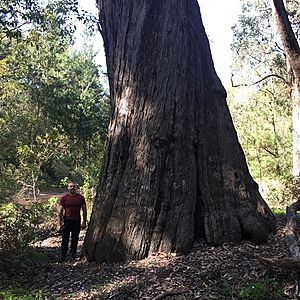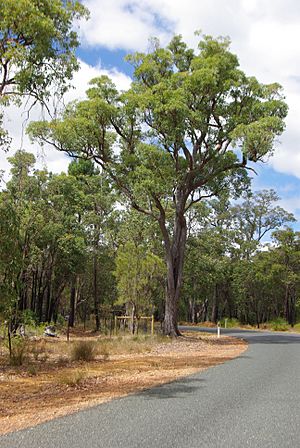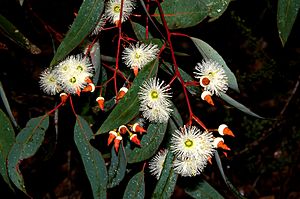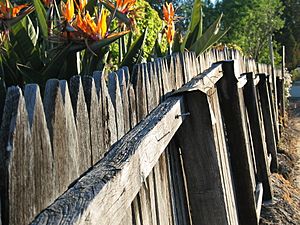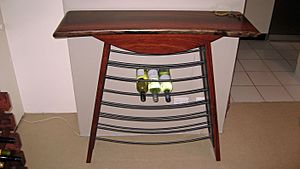Jarrah facts for kids
Quick facts for kids Jarrah |
|
|---|---|
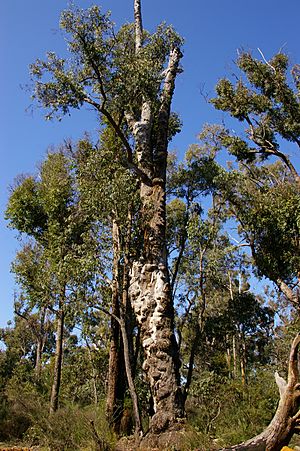 |
|
| Scientific classification | |
| Genus: |
Eucalyptus
|
| Species: |
marginata
|
| Subspecies | |
|
|
| Synonyms | |
|
|
The Jarrah tree, also known as Eucalyptus marginata, is a special plant found only in the southwest part of Western Australia. In the Noongar language, it is called djarraly. Long ago, people also called it 'Swan River mahogany'.
Jarrah belongs to the myrtle family, called Myrtaceae. It is a tall tree with rough, stringy bark. Its leaves have a clear middle vein, and it grows white flowers. The fruit are round and fairly large.
This tree produces very hard and strong wood. This wood is naturally resistant to insects. However, the tree itself can get sick from something called 'dieback'. Jarrah wood has been used to make furniture, floors, and even railway sleepers (the wooden beams that support train tracks).
Contents
What Does the Jarrah Tree Look Like?
Jarrah trees can grow very tall, sometimes up to 50 meters (about 164 feet). Their trunks can be 3.5 meters (about 11.5 feet) wide at chest height. More often, they reach about 40 meters (131 feet) tall with a trunk width of 2 meters (6.5 feet).
Some Jarrah trees are smaller, like a shrub, growing only up to 3 meters (10 feet) tall. Older trees have a special woody swelling at their base called a lignotuber. Their roots can reach deep into the ground, up to 40 meters (131 feet) down!
The bark of the Jarrah tree is rough and greyish-brown. It has deep grooves and peels off in long, flat strips. This type of bark is called 'stringybark'.
Jarrah Leaves, Flowers, and Fruit
The leaves grow one after another along the branches. They are long and narrow, often curved. Each leaf is about 8 to 13 centimeters (3 to 5 inches) long and 1.5 to 3 centimeters (0.6 to 1.2 inches) wide. They are shiny dark green on top and lighter underneath. You can easily see the main vein in the middle of the leaf.
Jarrah flowers grow in small groups of 4 to 8 buds. Each bud has a cone-shaped cap. The white flowers are 1 to 2 centimeters (0.4 to 0.8 inches) across. They have many stamens (the parts that produce pollen). Jarrah trees bloom in spring and early summer. After flowering, they produce round or barrel-shaped fruit. These fruit are about 9 to 20 millimeters (0.35 to 0.8 inches) long and wide.
How Was Jarrah Named?
The Jarrah tree, Eucalyptus marginata, was first officially described in 1802. This was done by a scientist named James Edward Smith. He wrote about it in a scientific paper.
Smith noticed that the trees he studied grew from seeds brought from Port Jackson in Australia. He also saw that Jarrah looked similar to two other types of eucalyptus trees. The second part of its scientific name, marginata, is a Latin word. It means "having a border" or "edged". Smith didn't say why he chose this name. But he did mention that Jarrah leaves had a thicker edge compared to another eucalyptus tree.
Where Do Jarrah Trees Grow?
Jarrah trees grow in the southwest part of Western Australia. They usually live in areas that get more than 600 millimeters (about 24 inches) of rain each year. You can find them inland as far as Mooliabeenee and Narrogin. To the south, they grow as far east as the Stirling Range.
The northern edge of their habitat is near Jurien Bay. Sometimes, you can find small groups of Jarrah trees in other places, like Kulin. Jarrah often grows as a small shrub (called a mallee) in places like Mount Lesueur. But usually, it is a tall tree. It typically grows in soils that come from a type of rock called ironstone.
Jarrah's Role in Nature
Jarrah trees are very important for their natural environment, called an ecosystem. They provide many homes for animals, especially birds and bees, while they are alive. As the tree gets older, its inside wood can decay, forming hollows. These hollows become shelters for animals.
When a Jarrah tree falls, it offers protection for animals that live on the ground. One example is the chuditch, which is a meat-eating marsupial.
Jarrah trees have adapted well to different environments. They can grow in places like the Swan Coastal Plain and also on the rocky Darling Scarp.
However, Jarrah trees are very sensitive to a disease called 'dieback'. This disease is caused by a tiny organism called Phytophthora cinnamomi. To stop dieback from spreading, especially in the Darling Scarp, people take steps like washing vehicles. They also limit access to parts of the forest that are not yet infected.
Uses of Jarrah Wood and Tree Parts
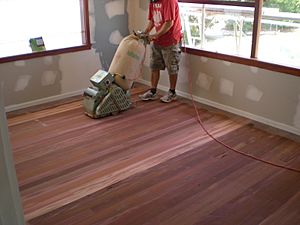
Jarrah trees produce a dark, thick, and tasty honey. But the wood is the most important part of the tree. It is a very heavy wood. When it is freshly cut, it is quite easy to work with. However, once it dries out, it becomes so hard that regular woodworking tools can barely cut it.
The long, straight trunks of Jarrah trees provide wood with a rich color and beautiful grain. This wood is resistant to termites. Because of these qualities, it is highly valued for making furniture, floors, wall panels, and outdoor furniture. The finished wood has a deep reddish-brown color and an attractive pattern.
In the past, Jarrah wood was used for general building, railway sleepers, and large support poles. In the 1800s, famous roads in other countries were even paved with Jarrah blocks covered in asphalt.
Jarrah wood is very similar to Karri wood, which comes from the Eucalyptus diversicolor tree. Both trees grow in southwest Australia, and their woods are often confused. You can tell them apart by burning a small, fresh piece of the wood. Karri wood will burn completely to a white ash. Jarrah wood, however, will turn into charcoal. This feature of Jarrah was important for making charcoal and iron at a place called Wundowie from 1948 to 1981.
Much of the best Jarrah timber in southwest Australia has already been harvested. Today, Jarrah wood is highly valued. There is even an industry that reuses Jarrah wood from old buildings that are being torn down. Larger pieces of timber came from very old trees harvested long ago. These big pieces are also recovered from older buildings.
Smaller pieces of Jarrah wood, like offcuts or dead wood, are sold as firewood. It burns well in wood stoves and gives off a lot of heat.
Jarrah wood is also used to make musical instruments, especially percussion instruments and parts of guitars. Because it resists rot so well, Jarrah is also used to build hot tubs.
Traditional Uses of Jarrah
The Eucalyptus marginata tree has also been used for traditional purposes by Indigenous Australians. Some parts of the Jarrah tree were used as medicine for certain sicknesses. For example, Jarrah leaves and bark were traditionally used to help with fever, colds, headaches, skin problems, and even snake bites.
Images for kids
See Also
 In Spanish: Jarrah para niños
In Spanish: Jarrah para niños



